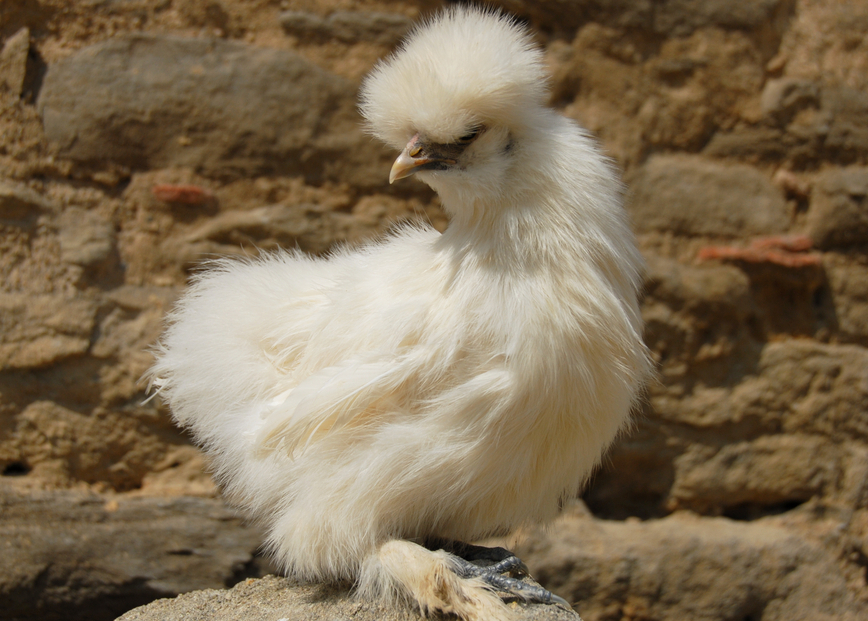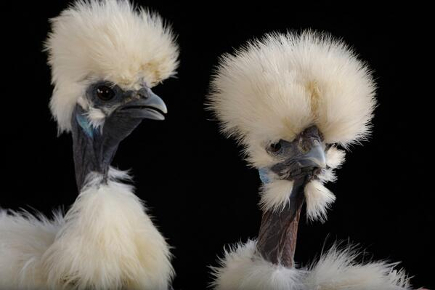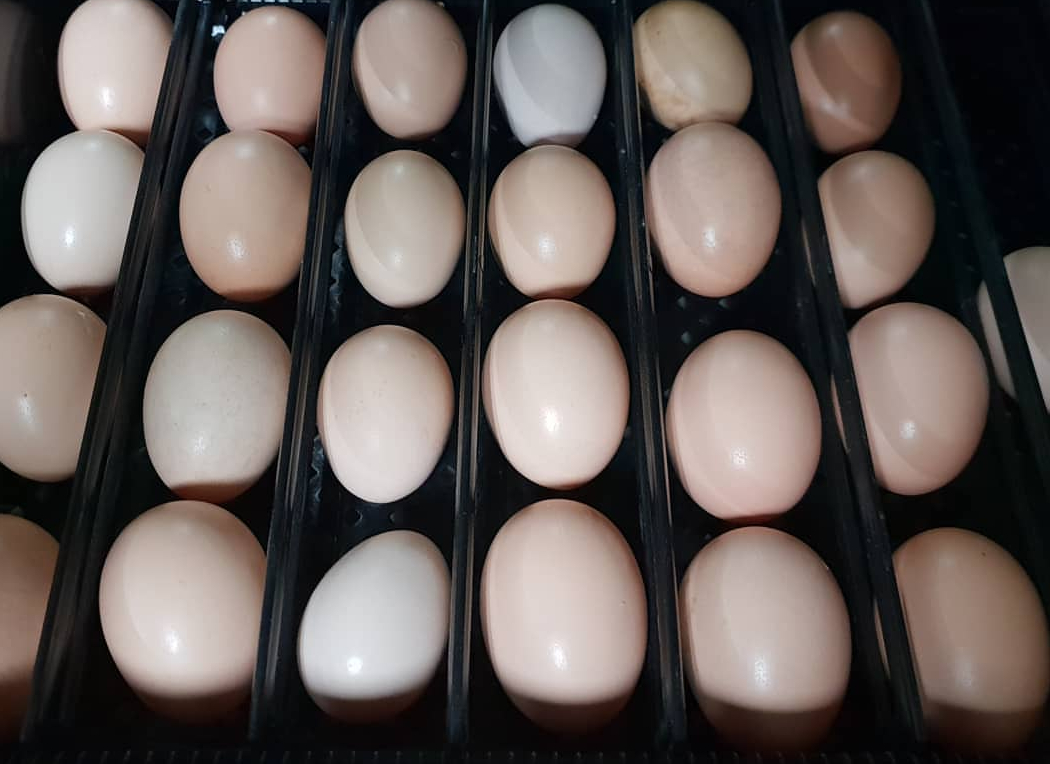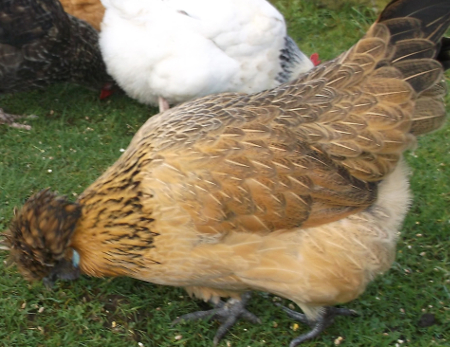Breeding Silkies and Showgirls

Breeding Silkie chicken and Showgirl bantams:
Silkie chicken reproduction is relatively easy if you can get enough eggs from your birds before they go broody. They produce an average of 3 eggs a week and are patient and eager broodies. The biggest problem in breeding Silkies or Showgirls is getting enough eggs to hatch.
You should prepare early when breeding Silkies. A Cockerel should not have more than 3 or 4 hens or fertility may suffer. It may also help to trim a few of the fluffier feathers from around the vent to improve mating success.
Below: Breeding Silkies and showgirls can be challenging.

It can be a frustrating experience breeding Silkies and you may struggle to get enough fertile eggs before the hens settle on nests. In spite of the popular wisdom about regular egg gathering making broody behaviour less likely, the Silkie hen will only lay an average of about 15 or 20 eggs before going broody.
Silkie eggs and incubation:
Fortunately you have a great broody here, so often Silkie breeders will forgo traditional incubation equipment in favour of Mother Nature. If this is your preferred option then it is worth hatching some Silkie cross birds as the harder feathering will prevent chick mortality from getting caught in the feathers.
If however you are breeding in quantity or if you have a particularly inbred line with hatching difficulties, you may want to look into cabinet type incubators with humidity control as this is something that seems to affect the hatch-ability of some of the good exhibition strains.
Silkies lay early in the New Year, often coming into lay toward the end of January as the days begin to lengthen. The tendency is to lay in flushes of 14 to 20 eggs at a time and then go broody.
This is great if you want to get a head start with the shows as the birds will have matured sufficiently by the time the major ones get underway and a Silkie does need maturity to show off its shape well.
Eggs should be collected a couple of times a day to help prevent broodiness and stored in a cool room. A spare room with the heating turned off is often the best.
Incubation is the same as for any other breed. It is the hatching which can be problematic and require extra vigilance. Silkie eggs have solid shells and some exhibition lines have a thicker membranes in the shell which, if there is a problem with humidity, the larger than average feet and enlarged head dome can make hatching difficult.
I have in the past helped out some of my chicks but most seemed to pop out like peas from a pod. Only your knowledge and experience of your line of birds can guide you here on what is best for you.
How many eggs can a Silkie sit on?
She can sit on 8 to 10 bantam eggs or 6 large fowl eggs. Any more than this will probably lead to some getting chilled and not hatching even if they are viable.
What age do Silkie chickens lay eggs?
In my experience it varies from 7 to 10 months to whenever they are good and ready and nothing much will hurry them up. But then we don't keep Silkies to be productive. I have had a few that never laid in their first year.
Selecting Silkies for Breeding
Breeding Silkies can be a very rewarding and fun experience.
First and foremost, I believe you have to have a purpose or reasoning for breeding. Knowing what you wish to accomplish is the first step in obtaining the best results.
Some people breed Silkies to keep as pets for their own flock; others breed for profit; while others breed following the APA/ABA standard for exhibition purposes.
When selecting your birds you are looking for birds that come as close as possible to the Standard in both sexes. Here you want to note the strengths and weaknesses of the male as well as the female. It helps if you have access to exhibition cages where you can have them together side by side for comparison.
The goal is to balance out these traits and offset the weak points of one sex with the strengths of the other sex. For example, if a male has a long back you would not want to breed him to a female with this same weakness.
You can do this by purchasing a copy of the “Standard of Perfection”, which is distributed by the American Poultry Association, or the “Bantam Standard”, which is distributed by the American Bantam Association. You can also read about the Silkie Standard at the American Silkie Bantam Club website.
If Silkies are your bird of choice I would recommend joining the American Silkie Bantam Club. Attending poultry shows and exhibitions are a great way to meet other breeders and educate yourself about the breed. There are also several forums on the Internet that focus on raising Silkies.
Once you are familiar with the Standard and you have a general idea of what the requirements are for the ideal Silkie you are ready to select the proper birds. I must note that it is on no account possible to acquire ‘the perfect’ bird that possesses all the characteristics desired; as well as a bird that has acquired a ‘show win’ considered perfect.
When looking for a Silkie, doing your homework can save you a lot of headache and money: first and foremost, ask questions about the bird and learn about the breeder.
Breeding birds with defects depends upon how serious the defect is. If the bird that has the defect is an outstanding bird in all other respects, then it is usually advisable to breed it; however, if your flock shows a tendency towards this defect it is better not to breed it at all.
There are several defects that are caused by incubation or condition rather than genetics such as crooked toes or yellow streaks in white birds, etc. If this is the case, then by all means breed; otherwise, do so with your best judgement forward.
Breeding birds with a disqualification is usually a big no-no. Disqualifications are likely to be defects which are harder to breed out and are therefore quite likely to be reproduced.
Some of these qualifications include incorrect number of toes, single combs, vulture hocks, etc.
It should also be noted that improvements are not readily visible within one generation. It is by the careful selection of breeders that we can start seeing improvement in our flocks.
Do not be afraid to breed closely related birds if you need to. Provided they are both in good health with no genetic defects it can be a an excellent method of fixing good points in a strain of chickens.
How to select eggs for breeding:
Choose eggs that are:
1. The correct size and colour for the breed.
2. Smooth, even, clean shells with no cracks.
Below: Silkie eggs for hatching. Evenly sized and clean.

Wrinkled eggs are from a bird that may have an infection and dirty eggs may harbour bacteria that can ruin a whole batch of eggs.
Can silkies breed with other chickens?
Yes, in most cases you can mix breeds of chicken in your flock. They generally get on very well. Silkies usually get on well with other chicken breeds, despite their unusual plumage, presuming you have several.
Below: One of many Silkie cross Barnevelders I use as broody hens.

They can breed with any other chicken in the flock provided the size difference is not to great. It is sometimes desirable to cross a silkie male with a flock of other broody bantams like Light Sussex or Barnevelder to produce a cross breed that is still a good broody and mother. You can get many more broody hens this way.
I have a whole flock of Silkie cross Barnevelders to use as broody hens.
Selection of breeding stock:
It goes without saying that good, secure housing and nutritious feed are of the utmost importance in all poultry undertakings, and this is especially true for breeding stock.
Another equally important consideration in the selection of the breeding stock is to choose birds that are fully matured, some breeds arriving at maturity much more speedily than others, and this has to be considered when setting up the breeding pens.
In selecting the stock birds of any variety, strong, vigorous specimens only should be bred from. Experience has proved that it is impossible to obtain strong healthy chickens from stock birds whose systems have been undermined by disease or afflictions in some form or other.
The natural consequence, in breeding from unhealthy birds on either side previous to the formation or fertilising of the eggs, is that the chickens produced will be weakly and almost worthless, though they may appear in their earlier stages to do all right, but, as sure as the sun sets, the latent disease in their systems will appear, and disaster ensue.
Rule 1 . No good and lasting results can be expected from unhealthy parent stock.
An old hand at poultry keeping once told me "As the fertilisation of the egg rests on the vigour of the stock cockerel, it is folly to allow the stock birds to run together right throughout the year. It is imperative, if strong and healthy chickens are desired, to remove the stock cockerel for at least four or five months in the year. This will allow the bird to recover his flagging energies, before being again placed in the breeding pen"
He was well into his eighties and had had much success over the years but the main piece of advice here is to allow all your breeding stock to have a good rest.
How many eggs can a Silkie sit on?
It works well for very small broodies like Silkies, but it is too small for a larger bird to turn around in easily. The last reason you may not want to have a broody hen hatch your eggs is that a hen can only reliably hatch a few eggs at a time. Bantams can't easily hatch more than six or seven large eggs at a time.
Do Silkie eggs hatch early?
So how long does it take Silkie and Showgirl eggs to hatch? We are all told it takes 21 days for chicken eggs to hatch, but sometimes they will hatch a little early, but I still stop turning mine on day 18.
I learned that the hard way the first time when I was candling an egg right before taking the egg turner out. It was day 18 and the little egg started chirping at me when I shined the light through it! I put it straight back in the incubator and it pipped an few hours later. Went on to hatch with no problems at all.
My bantams always hatch early whether they are in an incubator or under a hen it makes Little difference, they hatch 24 to 36 hours before large fowl eggs.
My Japanese and Serama bantams hatch on day 19. My Silkies normally on day 20.
Breeding Showgirls or Naked Neck Silkies:
This is relatively easy as the naked neck gene is an incompletely dominant trait. This means that even a single copy of the gene shows in the offspring to a varying extent. The idea is to choose excellent quality Silkies and get the naked neck in your line first.
For the first generation (F1):
If you want to breed your own Showgirls from Naked Necks and Silkies I suggest you first cross a Silkie male with a Turken (Naked Neck) hen.
Guessing which Showgirls are males is even more difficult than sexing Silkies and that is saying something!
But you can easily find the female offspring in this cross as all the females from this cross will have black skin because the gene for black skin is sex linked.
Select the naked necked females with 5 toes and the combs and crests that best match the standards.
Cross the Naked Neck female offspring with Silkie males and the to produce the second generation(F2). The reason you keep breeding back to Silkies initially is to improve type. You want the birds to be Silkies with the naked neck gene rather than a hybrid mix of Naked Necks (Turkens) and Silkies.
In later crosses, it matters much less but using a showgirl male is a better choice. If you use a Showgirl male on Silkie females, you get more Showgirl chicks for your investment. One Showgirl male with three females laying well could fertilise 12 eggs a week.
Improving Your Showgirls Further Generations:
Most breeders usually cross Showgirls with Silkies to improve type. The Showgirls I use are heterozygous for the naked neck gene. They are N/n (one naked neck gene and one not naked neck gene). These birds have more than just a few feathers on the front of their necks.
Breeding these N/n birds with Silkies produces 50% naked neck chicks and 50% normal chicks. The normal ones look just like regular Silkies but might have the poor type of the Showgirl parent.
It will take quite a lot of chicks and at least three generations before you get something decent. When you are happy you have the best birds you can breed both male and female showgirl to get the N/N which will give the an almost completely featherless neck.
How long do you wait before culling a bird from breeding?
This always gets a wide variety of responses. The simple answer is you should wait until the bird is fully mature before making your decision about whether or not to breed.
I personally never breed from a chicken in it's first season and always wait until the second year.
Birds with genetic defects can and should be removed from the breeding program as soon as it is obvious what afflicts the animal. Chicks with splayed legs for example should never be bred from even if they turn out okay.
